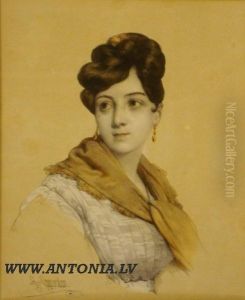Henrijs Grevedons Paintings
Henrijs Grevedons, born in 1775 and passing away in 1860, was a noted artist whose life and career spanned the late 18th and much of the 19th century, a period rife with artistic evolution and societal changes. His works and contributions, though not as widely recognized today as some of his contemporaries, played a significant role in the art scene of his time, particularly in the context of European art.
Grevedons was primarily known for his portraiture, capturing the nuances of personality and status of his subjects with a keen eye for detail and a masterful use of light and shadow. His portraits often reflected the social and cultural atmospheres of the era, offering insights into the fashion, demeanor, and aesthetic preferences of the upper class. This was a time when the European art world was transitioning from the Baroque and Rococo styles of the 18th century to the more expressive and diverse approaches of the 19th century, including Romanticism and Realism.
While specific details of his education and early career remain sparse, it is known that Grevedons was active in various artistic circles, engaging with many of the prominent artists and intellectuals of his time. His work was exhibited in several important galleries, and he received commissions from notable figures of the day, which helped to establish his reputation as a skilled portraitist.
Beyond his artistic legacy, Grevedons' life reflects the broader historical and cultural shifts of his time. The late 18th and 19th centuries were periods of significant change in Europe, marked by revolutions, the rise of nationalism, and the beginnings of the Industrial Revolution. As an artist, Grevedons would have been influenced by these events, and his works provide a window into the evolving societal norms and values of his era.
Despite the lack of extensive documentation on his personal life, Henrijs Grevedons' contributions to the art world are remembered through his surviving works. His portraits not only serve as artistic accomplishments but also as historical artifacts, offering a glimpse into the complex tapestry of European society during a period of profound change and development.
